While continuing my ramen quest, I decided that checking out the concentrated Japanese areas of town might be a good approach. There’s no defined “Japantown”, like there is for the Chinese and Korean communities, but there are basically two areas, one in Once, and one in Belgrano, where there are small enclaves of more traditional style Japanese restaurants and shops.
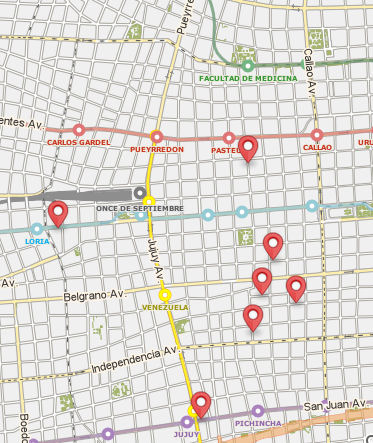
Now, as best I know, though I’m hoping someone knows of more to recommend, there are only a few real Japanese restaurants that fall within the borders of Once, or Balvanera barrio, but they are among the most traditional in the city – Yuki, Nihonbashi, Shogun, Sashimaya (which doesn’t have ramen, but I’ll get to at some point), and today’s feature, Ichisou, Venezuela 2145. There’s also a branch of Haru, a primarily delivery, sushi spot, just across from the Once train station, and just a tad outside the barrio to the south, the Okinawan Cultural Center has a sushi bar called Okiren – neither of these spots have ramen.
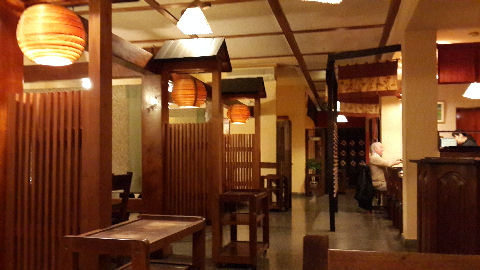
First off, pretty room, a little yellow in the lighting for my tastes, but well appointed. In the back there’s a washitsu, or “Japanese style room” – low tables where you basically sit on a cushion on the floor. I’m not a fan, I find it uncomfortable to eat in that position – it helps at some places where they have sort of a pit underneath the table where you can put your legs, but here, they don’t. I’ve visited twice (once solo, once with Henry), once sitting in the “Western dining room”, or yōshitsu. There’s also a small sushi bar with, I think, four seats.
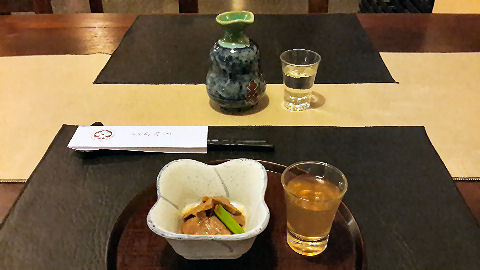
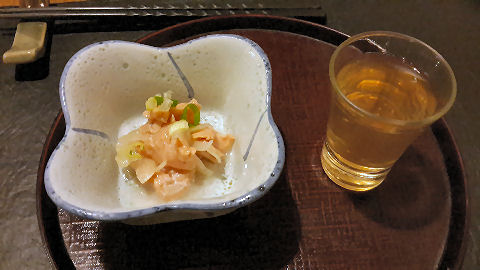
The menu is fairly extensive, and for the most part very classic. There are a few nods to local culture – some of the sushi rolls have cream cheese, for example. The menu also includes quite a few dishes that I’ve not seen on any other Japanese restaurant menus here. A small amuse is brought to the table after you order – on one occasion it was lengua a la vinagreta – pickled tongue, a classic local Argentine appetizer, though done with Japanese flavors added, and quite good. The other time it was a bit of cooked salmon in a little dressing that was less successful. Both times accompanied by a shot of sweet plum wine.
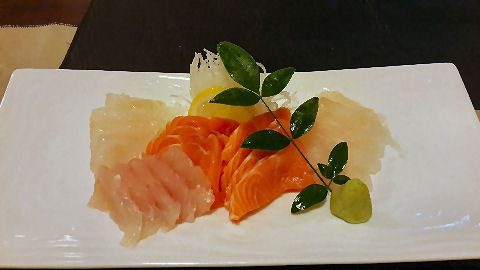
On my solo visit I ordered a sashimi combination – there are two, one with 18 and one with 30 pieces – and, for a change at a sushi bar here, it arrived with a real combination – three kinds of white fish (sole, mullet, and porgy), plus salmon. Generous slices, perfectly fresh. Excellent.
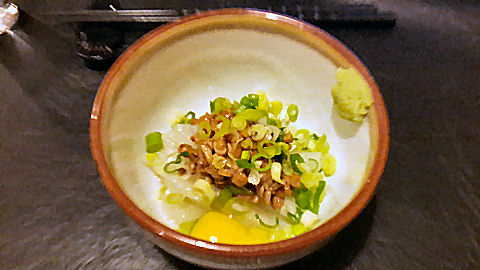
One of those unusual dishes, ikanattou – nattou are little fermented soybeans that are kind of sticky and gooey. They’re definitely an acquired taste and texture, and I’ve met very few non-Japanese people who like it. I love the stuff. Here, combined with thin threads of raw calamari, a raw egg yolk, and a good dollop of wasabi to mix together. The manager, who was supervising my waiter on my first visit (he was in training), looked at me like I was insane and asked if I knew what I was ordering, then walked away shaking her head. Then she, and both waiters in the place stood nearby watching me eat it, with looks of mild disbelief on their faces.
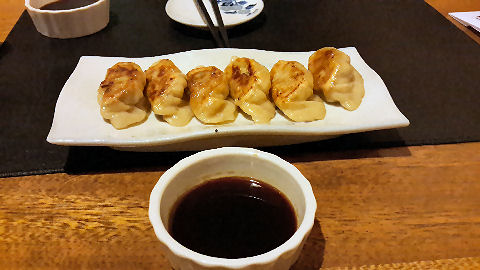
Quite good gyoza, maybe a little heavy on the green onion inside, and I wouldn’t have minded a dipping sauce that had a bit more umph to it.
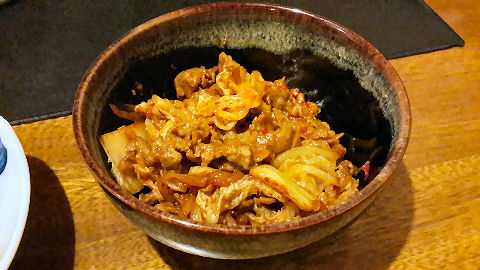
Another of the unusual dishes, this one with a nod to Korean influences in Japanese cooking, buta-kimchi, a delicious little appetizer of sweet, lightly charred pork (chashiu) sauteed with reasonably spicy kimchi. We both would have been happy with more spice, but that wouldn’t be traditional Japanese I imagine. This was one of my favorite things over both visits.
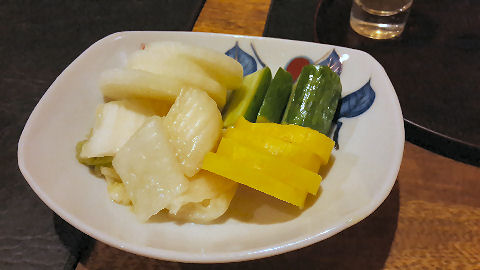
A little bowl of tsukemono, or vegetable pickles – two preparations of daikon, plus cucumber and akusay (napa/chinese cabbage) – perfectly done.
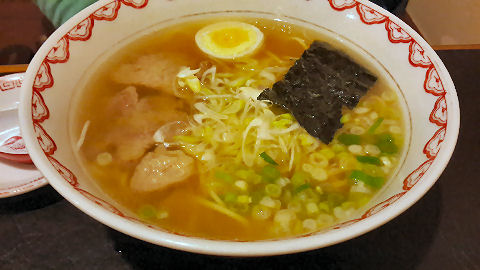
Now, being on a ramen quest, the first time I went I’d ordered up a half bowl of the regular ramen – after the sashimi and nattou it was enough. On my return visit I’d planned on ordering the other ramen, a champon style, which I mentioned in my last ramen writeup at Irifune. I’d figured Henry would likely order something else, but he went straight for the regular ramen, so I haven’t tried any other main courses. The regular ramen, a very clear, almost consomme style chicken broth, packed with slightly thicker, round cross-section ramen noodles that were cooked perfectly. Bamboo shoots, green onions, several slices of chashiu pork, a thick slice of a hard boiled egg (I suppose they throw the ends out, or use them in something else), and a leaf of toasted nori. Overall quite delicious.
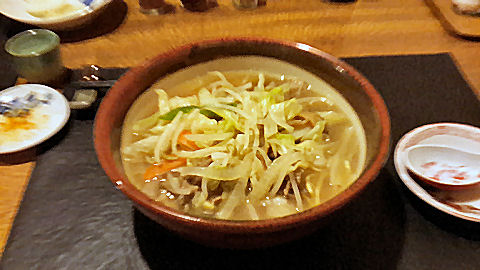
The champon ramen was less successful. The broth didn’t have that richness that I’d associate with the style, having a more sort of muddled, chicken pork combo flavor that just didn’t quite work for me. The noodles appeared to have been cooked separately as in a regular ramen, and it was just over-packed with shredded vegetables – bamboo, green onion, carrots, cabbage – with only a few thin strips of pork and a few somewhat rubbery strips of squid in it. Not at all the generous, hearty dish that, for example, Irifune served, nor even of Ichisou’s own regular ramen, especially given that it’s a third more expensive. I only ate about half of it – Henry decided to finish it off for me, but declared it not nearly as good as his.
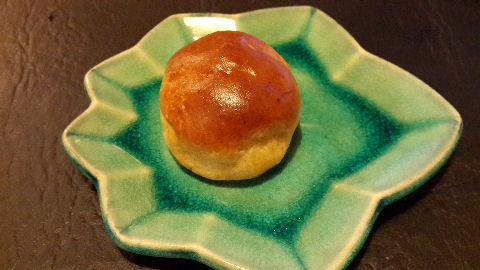
On my solo visit I decided to have a dessert, and left the decision in the manager’s hands. She picked the kuri manju, which is a traditional baked bun that should be filled with a delicious chestnut paste – the name actually translates as “chestnut cake”. These were filled with a sweet bean puree, which was good, but not as good as chestnut puree would have been.
So, overall. Love the ambiance and the traditional approach. Impeccable service. For the most part, delicious, beautifully prepared food. Expensive but not exceptionally so, and there’s a 10% discount if you pay in cash. My solo dinner with the sashimi combo, ikanattou, a half ramen, dessert, and a 280ml flask of good sake (they offer two – one cheap, one better), came in at 659 pesos before the discount, which brought it to 593 pesos, or, hovering around $60. Dinner for two with gyoza, buta-kimchi, tsukemono, ramen, champon ramen, and a flask of the cheaper sake came to 738, or 664 with discount, bringing it in around $70. The big difference in them being almost the same price was the sashimi combo, which racked up 260 pesos on its own, and a 76 peso difference in the price of the two sakes (why the cheaper one on the second visit? because Henry wanted it hot, rather than cold, and if you’re going to heat sake, there’s little reason to go for high quality stuff, it all tastes pretty much the same at that point). We’ll definitely be back to try more dishes.
Thank you, I look forward to checking these places out!
You’re welcome! And, if from your end, you know of any more that I’ve missed, let me know.
[…] México 1965, Once – I’d forgotten to “get back to” this place when I was looking at the different restaurants in the loosely defined Japan-town almost two years ago on my […]
Sushi isn’t just about the variety and quality of the fish, though obviously that’s extremely important. But “sushi” itself means, more or less, “things on rice”, and as such, the quality, flavor, and texture of the rice is one of the key things. Ichisou simply has what many, including I, would tout as the best sushi rice in town – it’s just the perfect consistency, flavor, and size for excellent sushi. And, literally, top that with pristine, delicious fish, and you’ve got a winning combination.